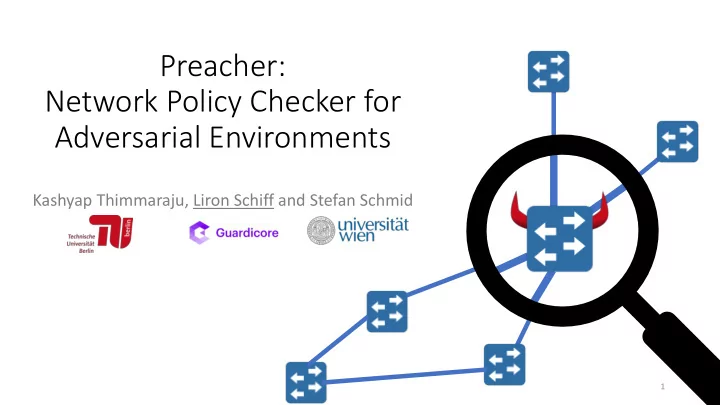

Preacher: Network Policy Checker for Adversarial Environments Kashyap Thimmaraju, Liron Schiff and Stefan Schmid 1
Backdoors and exploits • Network devices are very effective attack vectors • Provide access to internal networks • Transparent to many security measures • Hard to detect • Mostly used by state actors • Exploiting 0-day vulnerabilities • Compromising supply chains 2
Admin Attack model Internet • A compromised network device can run arbitrary malicious code. • Modify traffic • To attack network hosts (including DoS) • Report false configuration and state • To evade detection • Two attack building blocks: 3
Attack model (cont.) • Attack examples: a) Denial of service b) Port-scan c) Mirroring d) MitM e) Covert channel f) Re-route 4
Verifier Admin Naïve solution: Traje jectory Sampling (T (TS) Internet • Sample packets • Global set of hash values - Attacker avoids them • Send samples to verifier • Attacker corrupt them on the way • Compare trajectories to policy • Good for traffic monitoring, but not suited adversarial settings 5
Verifier Admin Split Assignment Traje jectory ry Sampling (S (SATS) [Le Lee&Kim DS DSN06] Internet • Sample packets • Independent sets of hash values - Attacker avoids them • Send samples to verifier • Switch should use encryption • Compare trajectories to policy • Designed for adversarial settings • But… 6
Verifier Admin SATS Limitations Internet • Sample packets • Security guarantees? • Fixed-hash-crafted injection! • Switch compatibility • Control plane security • Messages (samples and assignments) • Endpoints (verifier etc.) • Compare trajectories to policy • Obtain policy (network compatibility)? • Scalability? 7
Preacher • An improved trajectory sampling solution • Harnesses programmable network technologies • Uses robust and distributed design • Includes a security analysis and a prototype • Addresses all SATS limitations 8
Contributions • Sample packets • Security guarantees ✓ Analysis + evaluations • Fixed-hash-crafted injection ✓ Dynamic assignment • Switch compatibility ✓ SDN switch • Control plane security • Messages (samples and assignments) ✓ OpenFlow encryption • Endpoints (verifier etc.) ✓ Distributed design • Compare trajectories to policy • Obtain policy (network compatibility) ✓ SDN controller • Scalability ✓ Parallel design 9
Preacher Scheme Preacher • Cooperates with controller and Routing app. Hash (policy) Verification routing apps assignment • Sends hash assignments (switch Controller configuration) • Receives samples (e.g., PacketIns) Incoming Switch Topology Samples config. • Obtains a policy • Verifies samples Internet • For each sample computes other expected samples (using the policy) • Detects inconsistencies (with timeouts) 10
Preacher Scheme – Distributed and Parallel Use redundancy to improve Preacher security and fault tolerance! Routing app. Hash (policy) Verification assignment Controller Incoming Switch Topology Samples config. Internet 11
Preacher Scheme – Distributed and Parallel Use redundancy to improve Verification Hash assignment security and fault tolerance! Verifier Assigner • Hash Assignment • Each assigner configures a subset of switches Verifier Assigner (or pairs) Verifier Assigner • Compromise or malfunction of one assigner is not fatal • Verification Internet • Each verifier is responsible for a subset of hashes, and receives a subset of the samples. • Better performance and security (depending on subset overlaps) 12
Security Analysis Internet • An attack occurs along a directed path • Where the packet should have traversed • Detection requirement • Attacked packet hash is assigned before and after attack • Same for drop and inject • Hash assignments • Each switch is assigned with p of hash space. p is very small ( 𝑞 ≪ 1 𝑜 ). • Independent vs. pairs assignment 13
Security Analysis • Detection probability 𝑙 2 𝑙 1 • For independent assignment: 𝑄 𝑗𝑏 = 1 − 1 − 𝑞 𝑙 1 ∙ 1 − 1 − 𝑞 𝑙 2 ≈ 𝑞 2 𝑙 1 𝑙 2 • For pairs assignment: 𝑙 1 𝑙 2 𝑞 ≈ 𝑞𝑙 1 𝑙 2 𝑄 𝑞𝑏 > 1 − 1 − 𝑜 − 1 𝑜 − 1 • We assume #packets-till-detection follows geometric distribution. • We use common packet rates to get expected detection time . • We use common data center link capacities to derive expected total samples’ rate ( pps) . 14
Evaluation • Prototype based on ONOS-1.4 with OpenFlow 1.3 as controller. • Used services: Flow objective, Flow rule, Device, Packet-in • Clos topology with k=4 • Open vSwitch (OvS) for switches • Experiments goals: • Verifying analysis • Evaluating overheads • Switch • Controller • Evaluating throughput 1 core ≈ 1000 pps 15
Detection Time vs. Resources • With pairs-assignment • Attacks in small network can easily be detected within minutes • In big networks ~10 servers (~100 cores) are needed. • With simple independent assignment • Even in small networks it is very hard to detect. • In big networks it is infeasible. 16
Future work • Implementation with more programmable network devices • hardware switches, P4 switches and smart NICs • Experimenting at SDN datacenters 17
Summary • Preacher harnesses programmable network technologies • Uses distributed design to ensure robustness and security • Provides provable security • Open source prototype is available at: www.github.com/securedataplane/preacher 18
Recommend
More recommend